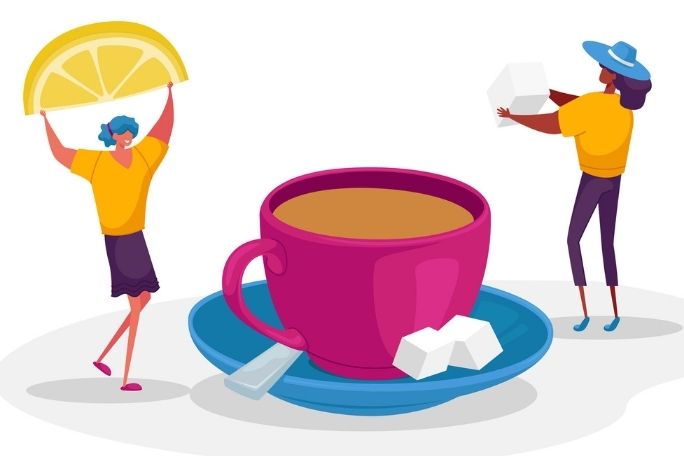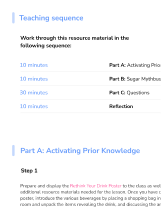Lesson summary
Have you ever looked at a food item and thought it was healthy only to discover it was packed with sugar and other foreign ingredients? Chances are that students have no idea how much sugar is in commercial drinks and packaged food and would probably opt for water or healthier options if they knew all the facts.
During this myth-busting lesson, students take part in a fun hands-on sugar match up game, organising and investigating the true amount of sugar that is hidden in drinks and food. The students create quiz questions to be asked in a sugar quiz, sharing their knowledge about the sugar in foods, and how it affects our minds and bodies. Get set for a fast-paced quiz, full of facts, in a race to learn more about sugar and your body.
Learning intentions:
Students will...
- understand the effect of sugar on your body
- understand what natural sugar is and where it is found
- understand what added sugar is and where it is added.
Success Criteria:
Students can...
- identify how much sugar is contained in fizzy and sugar-based drinks (flavoured milk, soft drink, and energy drinks)
- identify how natural sugars affect your body and mind.
Lesson guides and printables
Curriculum links
Select your curriculum from the options below.
Lesson details
Curriculum mapping
Australian Curriculum content descriptions:
Years 3 & 4 Health and Physical Education:
- Identify and practice strategies to promote health, safety and wellbeing (ACPPS036)
- Discuss and interpret health information and messages in the media and internet (ACPPS039)
Syllabus outcomes: PHS2.12, SLS2.13
General capabilities: Critical and Creative Thinking, Numeracy
Relevant parts of Year 3 & 4 HPE achievement standards:
Students interpret health messages and discuss the influences on healthy and safe choices. They understand the benefits of being healthy and physically active. They describe the connections they have to their community and identify local resources to support their health, wellbeing, safety, and physical activity. Students apply strategies for working cooperatively and apply rules fairly. They use decision-making and problem-solving skills to select and demonstrate strategies that help them stay safe, healthy, and active.
Cross-curriculum priority: Sustainability
This lesson is part of the wider unit of work Sugar By Half
Time required: 60 mins
Level of teacher scaffolding: High level – student direction, overseeing of food handling and support during the game show
Resources required
- A device capable to conduct research and take photos, such as an iPad or camera
- A device capable of presenting the Healthy Kidneys Education Poster
- A device capable of displaying the Rethink Your Drink Poster
- Selection of different drink containers (ie. juice, milk, lemonade, water, sports drink, etc)
- Other materials to conduct experiments such as sugar, teaspoons, bowl, poster paper, marker pens, ziplock bags, tape, coloured paper (sticky notes)
Skills
This lesson is designed to build students’ competencies in the following skills:
- Critical thinking
- Problem solving
Additional info
These lessons were developed in partnership with SugarByHalf and Filter Your Future. Filter Your Future guides children towards positive lifestyle choices to reduce the impact of preventable chronic diseases in future generations. Not many people know that type 2 diabetes and high blood pressure account for half the chronic kidney disease cases in Australia. When children learn about the function of the kidneys to clean the blood, how it balances water and salts, and remove waste from the body, they develop an understanding which motivates them to follow a healthier lifestyle.
Filter Your Future's vision is that young students are provided with evidence about the global health epidemic of weight-related chronic diseases and are empowered to make better lifestyle choices for a healthier future.
People who carry the burden of chronic disease all share the same vision for the future. They want their children and grandchildren to have a healthier future than themselves. By providing children with early awareness, prevention and health promotion, we provide pivotal education about wise choices to prevent chronic disease before poor lifestyle choices become unhealthy habits. Members of the Dialysis and Transplant Association of Victoria, Inc. (D.A.T.A.) and FILTER YOUR FUTURE® believe that this project will benefit our future generations and our nation.
Guardians of the Gums was written by Bee Healthy Stories; if you would like to see more of their stories, head to Bee Healthy Stories.
SugarByHalf promotes action to reduce sugar-related diseases so that we can live better, stronger and healthier lives.
Their message is simple: to reduce added sugar consumption by half. Eating too much added sugar is a key driver of serious health problems including obesity, type 2 diabetes, heart disease, tooth decay, dementia and mental health conditions. A poor diet also puts children behind their peers, affecting brain development, sleep and ability to learn. Poor diet choices ultimately mean that this generation of children could be the first in modern history to live shorter lives than their parents.
Much of the added sugar in our diet comes from the processed foods and drinks we consume. On average, we consume 14-16 teaspoons of added sugar per day. Teenagers consume more than 20 teaspoons per day. The World Health Organisation says we should limit our daily added sugar intake to 6 teaspoons for good health. To put that in perspective, there are 4 grams of sugar in one teaspoon. If something has 20 grams of sugar, that's 5 teaspoons of sugar.
This English lesson focuses on developing the skills and knowledge students need to critically consider messages about food and drink they are exposed to, thereby equipping them to be able to make healthy choices.
Talking about Health:
- Be mindful of students who may experience weight stigma. Some students may be sensitive to conversations around weight, body size or shape. Terms including obesity, weight issues, weight-problem and fat can be stigmatising for some people because they assign blame. It is important to note individual preferences around language vary. Research has shown using the terms ‘weight’, ‘weight gain’, ‘healthy weight’, ‘unhealthy weight’, and ‘high BMI’ are preferred as better alternatives.
- Be mindful about how you use the word ‘diet’. We recommend focussing students on the positive impacts of healthy nutrition and healthy lifestyles which help us to have stronger bodies and minds, feel good and sleep well.
- Steer students away from any focus on appearances by communicating that appearance does not determine your worth. We recommend the fact sheets from the Butterfly Foundation on body image tips.
- Avoid using labels such as obese or diabetic. Refer to people living with diabetes, people living with cancer, people with high BMI etc.


Welcome back!
Don't have an account yet?
Log in with:
Create your free Cool.org account.
Many of our resources are free, with an option to upgrade to Cool+ for premium content.
Already have an account?
Sign up with:
By signing up you accept Cool.org's Terms and Conditions(Opens in new tab) and Privacy Policy(Opens in new tab).